Dear Reader, in this age of AI created content, please support with your goodwill someone who works harder to provide the human-made. Sign up at the top of the lefthand column or bottom of this page. You will receive my hand illustrated monthly newsletter RESTORE NATURE and access to the biodiversity garden design course as I write...and nothing else, I respect your time. I am also removing the advertizing as best I can as its become intrusive inappropriate and pays me nothing.
Saving vegetable seeds
and growing a specialized seed garden
in permaculture
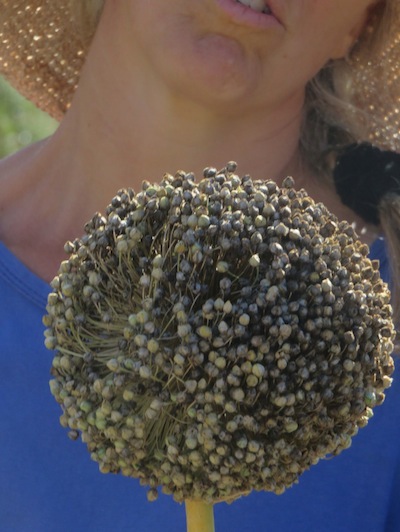 Leek seeds Leek seeds |
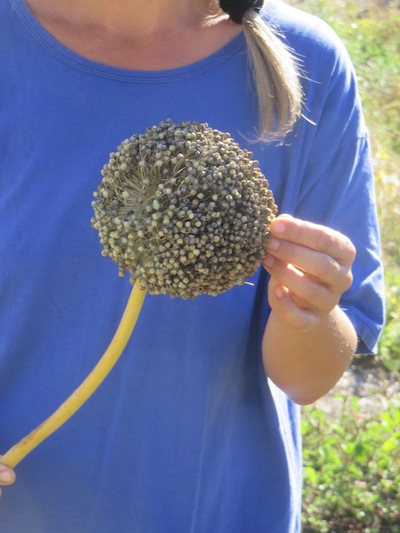 our SEED teacher our SEED teacher |
Its so beneficial to save vegetable seeds, for your pocket, for your garden's resilience and diversity, for food security and 'for the planet'. Last Monday I attended a very informative workshop on seed saving and keeping a seed garden, run by Phillipa at the Rocklands Urban Abundance Centre, the SEED premises on the corner of Park Avenue and Capricorn Way in Mitchell’s Plain.
This article will deal with background to the workshop, and then move on to what makes a seed garden unique and how to design one, the foundations of a good garden in permaculture which can be applied to a vegetable seed garden, a description of the garden work that needs doing, specifically in this season, the seed saving processes such as selection, harvesting, cleaning and storage, and some information about sexual reproduction in plants that affects saving seed which is true to type.
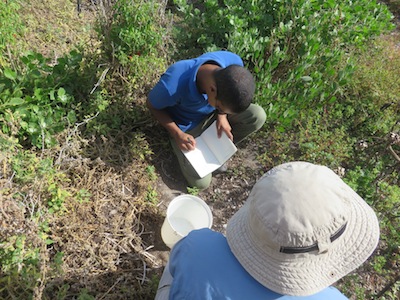 Saudiq makes notes in situ
Saudiq makes notes in situIt was a two day workshop. We mostly did walkabouts and talkabouts around the garden peering into the hearts of flowers, touching seed heads and harvesting different vegetable seeds and focussing on the plant's different pollination and seed forming peculiarities. We also prepared some beds for planting and learned to chop and drop properly, cutting the plant off just below ground before the roots branch, and we learned how to mulch and plant, and listened to two ‘lectures’ as a backup.
The other workshop attendees were Saudiq a well known permaculturist and SEED graduate, and Bernice, an organic farmer trained in the US, and the members of the Easy Peasy Program, which grows 24 packs of vegetable seedlings for sale at SEED and various markets for the convenience of home vegetable gardeners. It was stimulating to be in their company.
 The spot set aside for growing vegetable seeds
The spot set aside for growing vegetable seedsThe purpose of the workshop was to engender the revitalization of SEED’s beautiful garden for useful plants and vegetable seeds for their seed bank, an exciting and ecologically significant agenda. The plants, grown organically and allowed to seed in the sandy soils of Mitchell’s Plain, give rise to locally adapted seeds for the use of local gardeners and small farmers, as I see it, but SEED’s main stated purpose is the maintenance of genetic diversity. I know that the vegetable seeds they produce spread through the organic gardening and local permaculture community, because of SEED’s prominence, so the benefit of adapted seed multiplies, and the genetic safety net multiplies.
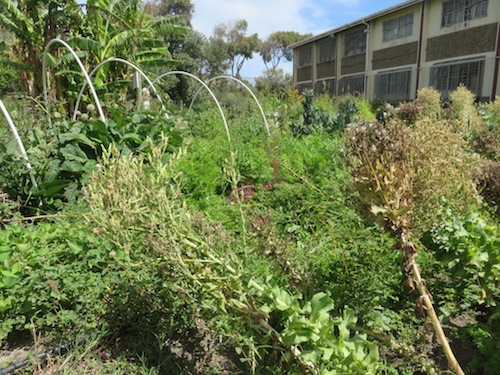 vegetable seeds flourishing near the Rocklands junior school
vegetable seeds flourishing near the Rocklands junior schoolAs Phillipa explained, a food vegetable garden seldom is allowed to go to seed. A seeding lettuce is seen as unproductive, or even counter productive and removed. The seeding leaf plants I’ve heard spread phytochemical signals to the others to start sexual reproduction and can turn all your lettuces bitter really quickly. When I worked for a permaculture vegetable grower, with the intention of producing food, we chopped the greens when they even just looked as if they might bolt, and they were done for if they got slightly longer internodes. Even in English idiom ‘going to seed’ is a pejorative. Here I saw a different agenda, where a satisfied or expectant eye is kept on the progress of the long flower shoots sent up by vegetable plants.
To have a garden specifically for saving vegtable seeds like this one in Rocklands, or just a self seeding garden, you need to plan for the plants needing more time in the ground. A lettuce takes 3 months on the average to harvest as food in our climate, but 9 months to produce ripe seed, so that is three times the time. But fortunately to save vegetable seeds, you need fewer plants than one would for market garden production or to feed many people, so that the seed garden need not be immense. Obviously the more plants the better, but a population size of 80 to 100 plants for outbreeders like the Allium family (including leeks) and 20 for inbreeders like chillis is a good basis.
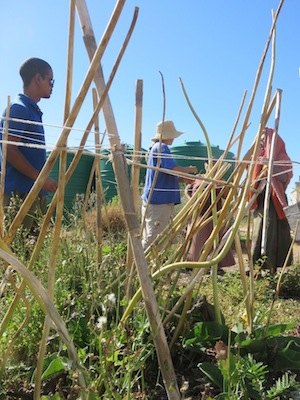 Vegetable seeds are borne on tall stalks, these are leeks
Vegetable seeds are borne on tall stalks, these are leeksYou can use plant parts judiciously for food and other purposes in a seed garden, but you need to plan differently for a seed garden, specifically for the changes which occur in the plant at seeding time. A compact low growing little lettuce suddenly puts out a tall flower stalk that needs to have space. As you can see in the photograph, the seed heads of the leeks were taller than humans. Fruit seeds may be dispersed by birds and animals, but the small vegetable seeds are dispersed by wind, mice, birds and merely growing tall enough. The natural tendency of the seed head on its long stalk is to lean over and lie down on the ground, distributing the seed as far as possible from the mother plant. To keep the vegetable seeds dry so that they can be collected easily and stored away for a long time, one has to provide support for the tall spindly stalks with their heavy seed heads so that they cannot fall.
Preparing beds for growing vegetable seeds
When your actual crop is vegetable seeds you prepare the beds in the same way you prepare for growing food in permaculture. The general rule in our climes is to cover the soil and slow down evaporation.
Phillipa ran us through the strong foundations for a permaculture garden that can also be applied to seed gardens, and these follow now.
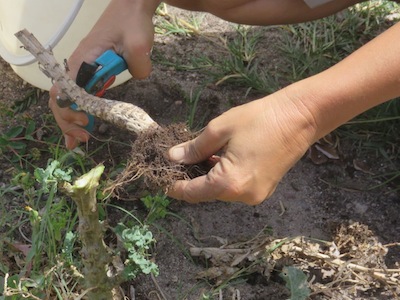 To chop and drop, cut old plants off just below the ground, or uproot, cut small and drop right where the plant used to grow
To chop and drop, cut old plants off just below the ground, or uproot, cut small and drop right where the plant used to grow8 Foundations of a resilient garden
1 A healthy soil environment
You need a living soil, so feeding the soil microbes with organic matter is important. A healthy soil life keeps down the pathogens through competition, predation etc.
build compost
mulch from sources in the garden
chop and drop
plant green manures
create mulch banks or plants you can harvest for mulch
bring in organic material
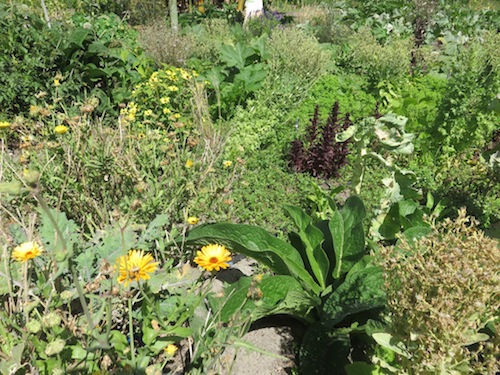 flowers for bees and pests, mulch plants and seeding vegetables
flowers for bees and pests, mulch plants and seeding vegetables2 Plant diversity
Plant diverse food plants as well as plants for many purposes such as those below, and mix them in your plantings.
mulch
green manure
pathogen control with aromatic herbs and trap crops
saving vegetable seeds
food
3 Habitat diversity
Provide good habitat for the insects that fertilize your crops and predate your pests with the following:
Mix your planting to confuse pests.
mulch and log and compost piles
flowers for bee fodder
windbreaks
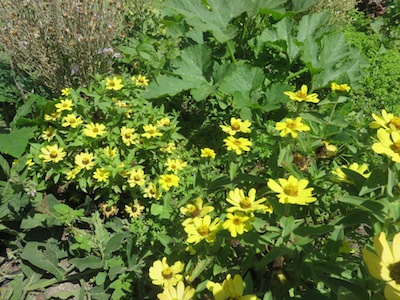 edible flowers, pest repellent, medicine and bee's delight
edible flowers, pest repellent, medicine and bee's delight4 Stacking in layers
height stack in levels of different height using all available space
time stack with short lived and long lived plants, and sequence through different seasons for effective occupancy of space
5 Shelter
Determinewhat forces act on your garden and how can you shelter your plants and help support them. Think of
wind
sun
water flows
pollution
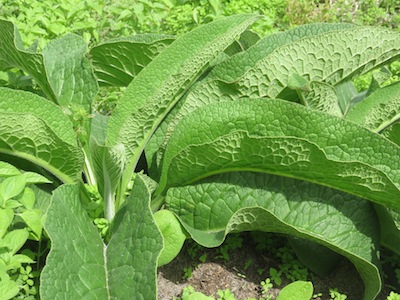 Comfrey, for mulching and accumulating minerals, also has flowers
Comfrey, for mulching and accumulating minerals, also has flowers6 Multifunctionality
Try to get many different functions out of every planting and every plant.
7 Water wise management
conserve water by shading soil with mulch and living ground covers
feed the soil with organics to make it into a sponge
use an irrigation system that works for you not vice versa
2L coke bottles with punctured lids berried upside down work when you have a small budget or want to recycle
Use micro jets, underground perforated pipes or drip irrigation which are low down if there is drying wind
get your irrigation pipes level and get the spacing right to save on water
use overheads with large drops that reduce evaporation and are less likely to be blown away
8 Good design
Put thought into planting design
Design for beneficial plant combinations and make a planting plan focussed on propagating vegetable seeds for each season, detailing where plants go
Know each plant's form of seeding heads and plan for trellises and support to prevent seed heads falling on the ground
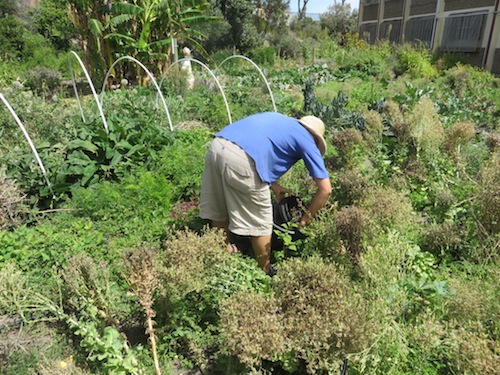 Shaking the lettuce seeds off the living plant into a bucket
Shaking the lettuce seeds off the living plant into a bucketSome ways of applying your foundations in a garden
As you harvest your vegetable seeds from last season, prepare for the next planting. After you have harvested the seed, chop and drop the plant, to keep giving back nutrients where they were extracted, and close the nutrient cycle, and scatter comfrey leaves in the area as comfrey accumulates nutrients.
If you have Kikuyu where you want your seed bed, you can mulch heavily to kill the grass.
Identify resources for mulching the beds. When laying beds use all organic material for the beds. Only make compost when all the mulching is done. Direct mulching of beds and covering all naked soil should take priority over making compost so don’t chop down plants and cart them off to the composting area until your soil is covered. Compost should be used as a top dressing on the soil or mixed in a plant hole. It must be under the mulch in order not to blow away.
Check the irrigation is working.
Have the area dedicated to a seed bank and make signage for communicating with people sharing the gardening. If they do not know what you are doing they may pull out your plants which have bolted and started flowering or gone to seed.
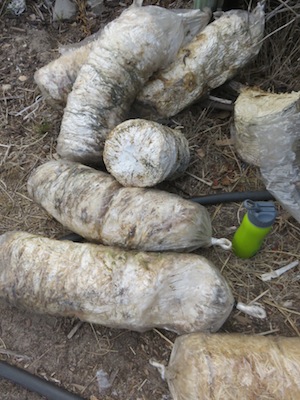 bags of dense mycelium
bags of dense mycelium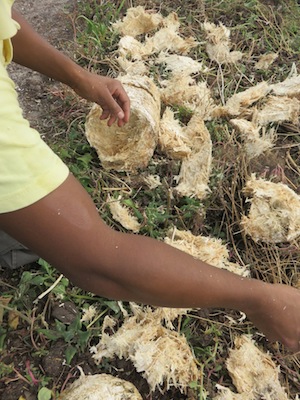 Saudiq tears up and scatters it
Saudiq tears up and scatters it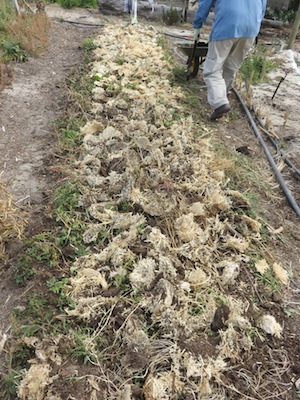 the bed covered with mycelium
the bed covered with myceliumWhen we did some bed preparation on the second day, we had already collected seed from the beds. Phillipa did a quick assessment of available organic material and decided to chop and drop because there was a lot of wild growth and plants with spent seed heads. The only plants we removed completely were thorny as it would not be good to have them multiply, or leave their thorns in the bed. We then scattered some aged horse manure on the beds. Saudiq decided to source some straw based mushroom waste and add that, to increase the soil organics and possibly also propagate ‘free’ adapted mushrooms. The benefits of mushroom mycelium to the ecology of the garden are well known. Then we mulched with coarse dry un-decomposed garden refuse from the top of the compost heap. Finally we planted some tough indigenous plants as windbreaks to the east and gave the beds a good watering by hand.
 Phillipa moving aged horse manure
Phillipa moving aged horse manure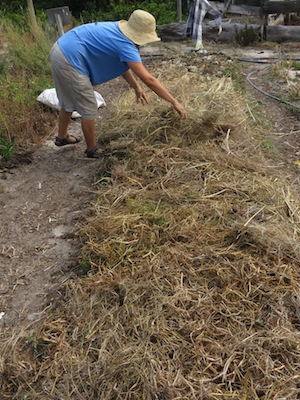 Phillipa mulching the bed
Phillipa mulching the bed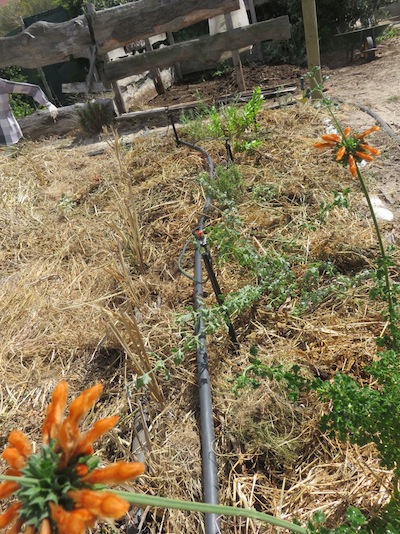 native plants for windbreaks
native plants for windbreaksHow much nursery space do you need to raise vegetable seeds
If you need space for a certain number of parent plants to guarantee the selection of good vegetable seeds you can calculate the number of six packs needed, based on the breeding population, double this, and then go by area of the six packs which will lead you to roughly 1m2 of nursery space for every 10m2 of garden, based on six pack size. So for this 100m2 garden you need 10m2 of nursery space.
When to sow for the seed garden
Late February through to May is planting time for winter crops. In colder areas plant early because the seedlings must be a month old or twenty to thirty cm high before the cold starts, then they will continue to grow.
If they are not big enough they will just sit and stagnate in their growth when it gets cold. I know all about this from experience. March, our present month is a good one to sow for a winter garden. It is also a good time to sow cover crops or green manures.
Winter crops
Legumes: peas and broad beans,
Umbelliferae carrots, parsnip, celery, dill, fennel, coriander
Amaranthaceae: subfamily Chenopodioideae English spinach, beetroot, chard
Aizoaceae: New Zealand spinach, purslane
Compositeae: lettuces and artichoke, corn salad, a tiny little lettuce and
Brassicaceae: cabbage, cauliflower, broccoli, kohlrabi, brusselssprouts, rocket, turnips, radishes, choi, chinese cabbage, watercress, mustard
Amaryllidaceae: leeks, garlic and chives, only some onions
Urticaceae: nettles
A note on onion bulb formation and seasonality
Onion bulb formation depends on day length and photoperiod. This helps me explain certain crop failures.
12-13 hours of daylight (short day type)
16 hours (long day varieties) with medium daylengths in between.
Bulb formation is faster on warm days but actually a response to the night length, if its too hot they don’t thrive. The equinox with equal day and night length is the 20th March and thereafter our days are getting shorter than 12 hours so bulb formation is unlikely except in spring and summer.
Green manures for winter
Mustard, legumes such as white clover, lupins, seradella and vetch.
The March gardening tasks for growing your vegetable seeds
prepare beds, chop and drop, compost, look for mulching and other resources,
sow vegetable seeds in nurseries using your planting plan, sow direct in beds: peas, beans, carrot, radish, turnip, parsnip
harvest, dry, clean or package your vegetable seeds
The seed saving processes
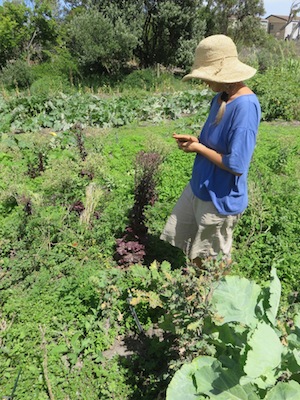 Phillipa checks the readiness of the red lettuce seed
Phillipa checks the readiness of the red lettuce seed1 Selection
Choosing plants to select seed from is as simple as deciding what characteristics you want, then thin, chop or remove the rest.
Harvest for longevity, taking the seed from the plants which have taken the longest to go to seed from planting. ‘Rogueing’ is pulling out early seeders, and ones with undesirable characteristics.
If you have neglected your beds, see this as an opportunity. Look at what has survived because it is probably the hardiest and its seed will give some well adapted resistant plants that can cope with the vagaries of your climate. Vegetable seeds adapt in about three generations to your locality or garden.
Apparently if you allow your vegetable plants to go to seed, you will eventually have a self seeding vegetable garden, and spare yourself a lot of manual labour. All that needs doing then is to transplant the seedlings which come up thickly around the mother plant and spread them out. Self seeding plants can also be used later as chop and drop. Many weeds can be eaten, such as goosefoot, purslane and amarinth.
2 Harvesting vegetable seeds
The seeds last better in a mulched garden, another good reason for mulching. Plants still need water during flowering and seed formation, so don’t stop watering. Birds love Brassica seeds and we need to net the seed heads, even green ones. Some flower heads will need exclusion based on their system of pollination. This will be discussed under pollination.
Don’t harvest green vegetable seeds, harvest only those which are dry and have changed colour or in the case of soft fruits choose fully ripe ones. Chillis can be collected when the fruits are ripe and wrinkly. Harvest your seeds and then keep them and dry them out some more.
The actual physical means of harvesting vegetable seeds differs depending on the plant and you will soon discover what is effective. We humans and our ancestors have been doing this for so long that it is instinctive. Calendula can be plucked and others rubbed off. New Zealand Spinach seeds are borne close to the stem and drop off easily, so gliding along the stem gently and collecting them in curled fingers is good. Harvest lettuce seed as soon as the down appears by shaking them into a bucket the same day. Place the bucket on its side to let out the numerous insects which love lettuce flower heads. It may take two days for the insects to leave the lettuce seeds in the bucket and walk away.
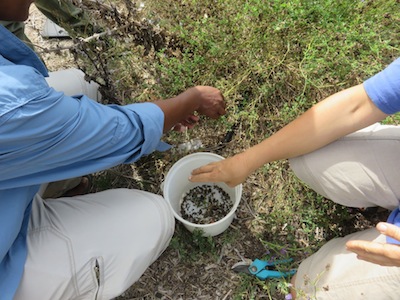 saving NZ spinach seed saving NZ spinach seed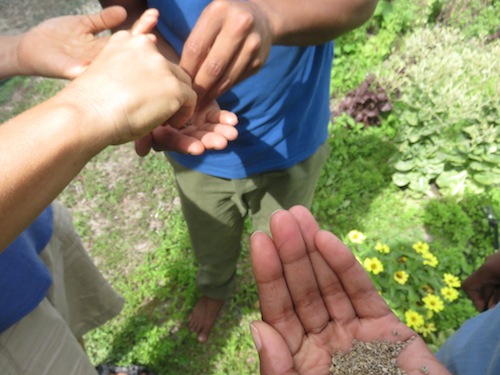 we learn best hands on we learn best hands on |
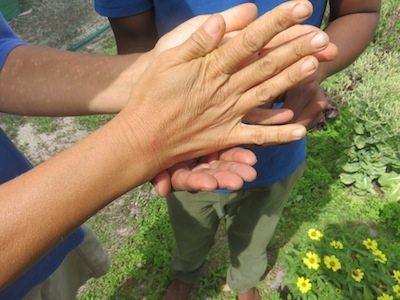 Rubbing to get carrot seed Rubbing to get carrot seed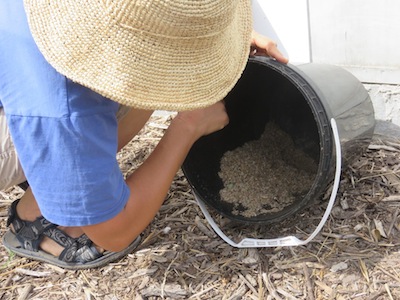 waiting for insects to leave waiting for insects to leave |
3 Cleaning
Chaff can be removed from vegetable seed, or not. It can be protective but can also harbor insects. Don’t over clean. Rubbing off the hairs on a carrot seed is excessive. Remove only the excess organic material like down on lettuce, and the leaves and stalks. If you clean the seed a bit you can see the quantity of seed you are working with better. Store only the seed that is without disease or insect infestation.
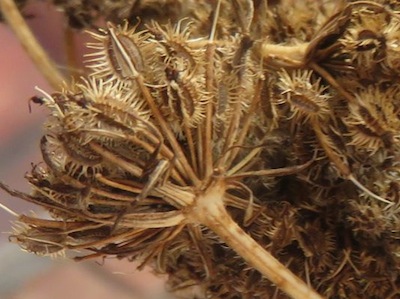 Carrot seeds
Carrot seeds4 Storage
Store cool and dry and dark in glass jars. Phillipa doesn’t recommend the fridge, which I’ve used to keep all my vegetable seeds this year. Oh dear. Heat is the biggest killer of seed. Do not leave your seed in a hot car or in the sun.
We should package when the seed is completely dry only. The holder too must be completely dry. After harvesting, clean the seeds and then dry them further for a few days and only pack them after a succession of warm dry days. Label them with their name, date and place of harvest. You may want to reproduce vegetable seeds from a good ‘vintage’ year for the crop. Protect the seeds from mice and rats (paper is dry but chewable, so perhaps paper bags in glass jars are a good combination). Protect your vegetable seeds from weevils especially the beans, peas, rice and mielies. The weevils may already be in the seed. Research the life cycles of the insect pest and what time in the cycle intervention will have the most impact. For example weevils are already in the bean seed but three days in the freezer will kill the larvae.
It is important to understand the category of pollination mechanisms of the plant whose seed you want. This involves flower sex, and pollination agent, like wind, bees etc. All this detailed information is hard to memorize and Phillipa recommends a trusty reference book of your choice for this purpose.
The importance of genus, species and variety for breeding
vegetable seeds
A vegetable plant will have a common name we know, like ‘cabbage’, and then a Latin name, which consists of genus, species and variety, for example its full name will be Brassica oleracea var. capitata. The genus, species and variety are not just names based on appearance, they have implications for breeding. The genus denotes a group of genetically closely related plants, the species a subgroup of these, which often look nearly identical, but in a species with enormous diversity the varieties can look very different.
Originating in the same wild plant, and being in the same species, means the plants can fertilize each other and reproduce. By definition, a species is a group which can breed. The variety is a subgroup of the breeding group, that is bred to look, taste or behave differently, but different varieties can still breed together. These are like the different breeds of dogs. All the different types of dogs can breed with each other, and the mix may not be desirable.
An example in the humble cabbage
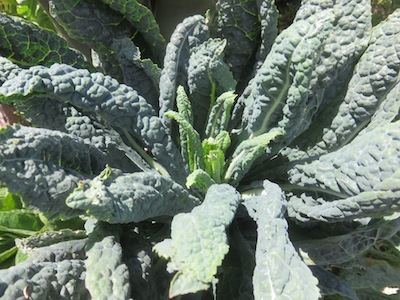 Brassica oleracea the most variable vegetable
Brassica oleracea the most variable vegetableBack to the cabbage, head cabbages, broccoli, collard greens, brussels sprouts and kohlrabi all were developed from the wild cabbage B. oleracea var. oleracea or colewort, by farmers selecting seed over an enormous amount of time, starting in pre-Roman Europe. Cabbage needs to be pollinated by insects and self pollination is impossible. This means if broccoli pollen gets to head cabbage stigmas, you will get seed that produces a mix of the two, and it may not be what you or your customers want, and no one will know till the seed comes up in their garden.
Types of plant reproduction
Sexual reproduction as in animals, involves meiosis, or a process of splitting the DNA so that half of the DNA of each parent comes together to make a full set, and a whole new individual with new characteristics. Asexual reproduction does not involve meiosis. A kind of asexual reproduction called vegetative reproduction is very common in plants. Horticulturists use vegetative reproduction to take cuttings and grow roots from a stem to form a new individual identical to the parent. These are often called clones of the mother plant and are good for ‘copying’ fruit trees that bear well, for example.
In plants sexual reproduction occurs using pollen, not sperm as in animals. The pollen is transferred from the male parts of a flower to the female parts of a flower. In the female part of the flower the fertilized ‘ovary’ forms seeds inside a fruit.
Cross pollination or outbreeding
In cross pollination or outbreeding, the pollen goes from one individual plant to another individual. Cross pollination needs a pollinator, something like a bee or wind, to transfer the pollen. To get insects to transfer the pollen the flower has to be attractive to them, colourfull and large.
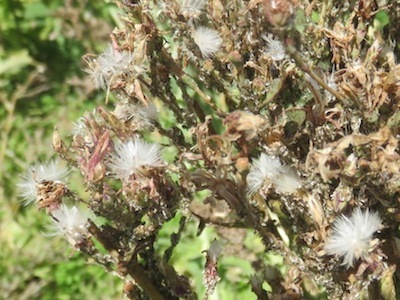 If lettuce goes downy harvest seed ASAP or the wind will
If lettuce goes downy harvest seed ASAP or the wind willSelf pollination or inbreeding
In self pollination or inbreeding, the pollen can merely drop onto the female parts of the same flower without the action of any other agent, to fertilize the flower. Such flowers can be very small and inconspicuous. In self fertilization only one individual gives rise to the seed. There are still variations, as each time the parent produces the tiny female and male germ the DNA splits differently, but still, its from the same individual, so it is pretty similar in characteristics. The resulting seeds will produce more uniform progeny and plants which are very similar to the parent.
Protection against
unwanted cross pollination
Sexual characteristics and the pollination vector (bees, wind etc.) determine the type of isolation needed to keep a pure strain.
The perfect flower and its implication for breeding
There are perfect flowers which have male and female on the same flower. These can often be self pollinators, or inbreeders, but also cross pollinators through being incompatable for self pollination, often because of timing, the male and female parts of the flower appearing at different times.
The practical implication is that you can grow different bred varieties of self pollinating plants in your garden. Some need to be separated a little, depending on the agent of pollination. Chillis can self pollinate, but they can be pollinated by insects, so you can grow different varieties but they must go under nets before flowering to keep the insects out.
The imperfect flower and its breeding needs
Imperfect flowers have male and female parts in different flowers, or on different plants. Often the pollen will have to travel all the way to another plant to accomplish fertilization, making them outbreeders, as is the case with true Spinach, and New Zealand spinach.
BUT
Because outbreeders exchange pollen between different individuals this means that pollen from very different varieties of the same species of plant can be exchanged, and lead to fertilization and you will get offspring very different to the parent. For keeping the seed uncontaminated and your plants breeding true to type it is necessary to grow only one variety of each species of outbreeder. This is normally not a problem except where there is enormous diversity in one species.
Families of plants
and their characteristics
Brassicaceae
Cabbage, cauliflower, broccoli, kohlrabi, brusselssprouts, rocket, turnips, radishes, choi, chinese cabbage, watercress, mustard.
With high diversity in one genus, there is a danger of cross fertilization. The pollen travels far and we need to prevent crossing by either growing only one kind, or we must prevent contact.
Broccoli, cauli, cabbage, kale are all the same species and crosspollinate naturally. Hybrids are not fertile or they are ‘unstable’. It is recommended that you grow one variety in a species at a time. Siberian kale is a different species but most other brassicas are in the same species. Select the plants you want seed from. Tie the heads together and cover them with a waterproof bag. Cut back all other Brassicas before flowering.
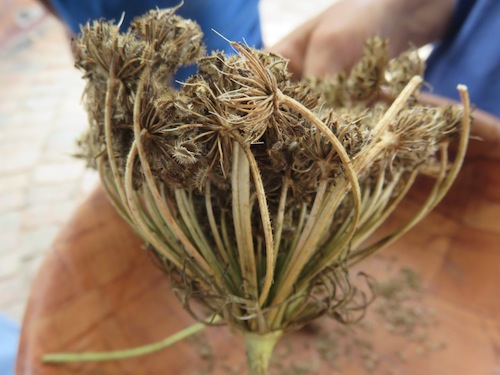 The beautiful double umbel of the carrot seed head
The beautiful double umbel of the carrot seed headUmbelliferaea
Carrots, parsnip, celery, dill, fennel, coriander, angelica
Aromatic with an umbel shaped inflorescence, outbreeders, with perfect flowers, needing a larger breeding population, but self incompatible, they must pollinate another flower on the same plant or on another plant. With carrots you can thin out the small ones and then let the big one’s seed. Carrots are an outbreeder therefore they need a higher breeding population.
Amaranthaceae : subfamily Chenopodioideae
English spinach, beetroot, chard
Chard is a biennial.
Compostieae
Lettuces, artichoke, corn salad
Lettuce have perfect flowers with male and female on the same flower so they do not cross fertilize a lot, so different varieties can be planted in the garden. However insect activity can cause crosses so it is better to exclude insects with a bag on these plants too. Lettuce is highly attractive to insects. Do plant them slightly separate, because of the slight danger of pollen transfer, and group similar varieties together for the same reason.
 A squash with withered stalk, ripe for seed harvest
A squash with withered stalk, ripe for seed harvestCucurbitaceae
Squash, pumpkin, cucumber, courgette.
Male and female are in separate flowers but are on the same plant. Thus they are imperfect flowers and different varieties can cross. To prevent this they can be hand pollinated and then taped closed. I also hand pollinate before isolating the flowers in bags to prevent the tiny fruit from being stung by cucurbit flies. Phillipa recommends millet tea for repelling fruit flies. Most fruiting plants you need to harvest when fruit is overripe. With cucurbits wait until the stem dries.
Leguminaceae
Runner beans, bush beans, cow peas, broad beans
Legumes have perfect flowers with male and female parts and can self pollinate even before the bud opens. They can cross too but don’t need to. Bush and runner beans are in a different species. But do not mix bush beans in one bed, to reduce the likelihood of cross pollination. Bees visit only one type of flower per trip and this also helps.
Amaryllidaceae
leeks, garlic and chives, onions, garlic
Amarylidaceae can also cross
Poceae
Zea mays
Mielies also crosspollinate and can get mixed up genetically. The male flower is the little dry looking husks, the female stigmas are the long strands. Each kernel has a separate strand. They are wind pollinated.
Solanaceae
Chillis, peppers, tomatoes, potatoes, tamarillo, tomatillo, aubergine, and many other vegetables.
Capsicum have perfect flowers which are self pollinating, but insects do visit, which means crossing can occur and all chillis and pepper can cross, therefore you need to exclude insects. Just cage the plant. They do not need insects to be fertilized.
Thanks and appreciation
I am so grateful to have been to this workshop, and I hope one day I will be able to participate in a plant breeding program that conserves the diversity and resilience to this climate of local plants. I hope at the very least to be growing plants for food forests that rehabilitate our blighted, drought worsening, people alienating urban landscapes.
------
home page for lots of links to information on natural gardening
------
soil2soil a sanitation to rehabilitation project engendered by myself and Riyaaz Ismail
------
------
SEED, an NGO that is one of the foundations of permaculture and community gardens in Cape Town
Restore Nature Newsletter
I've been writing for four years now and I would love to hear from you
Please let me know if you have any questions, comments or stories to share on gardening, permaculture, regenerative agriculture, food forests, natural gardening, do nothing gardening, observations about pests and diseases, foraging, dealing with and using weeds constructively, composting and going offgrid.
SEARCH
Order the Kindle E-book for the SPECIAL PRICE of only
Prices valid till 30.09.2023
Recent Articles
-
garden for life is a blog about saving the earth one garden at a time
Apr 18, 25 01:18 PM
The garden for life blog has short articles on gardening for biodiversity with native plants and regenerating soil for climate amelioration and nutritious food -
Cape Flats Sand Fynbos, Cape Town's most endangered native vegetation!
Apr 18, 25 10:36 AM
Cape Flats Sand Fynbos, a vegetation type found in the super diverse Cape Fynbos region is threatened by Cape Town's urban development and invasive alien plants -
Geography Research Task
Jan 31, 25 11:37 PM
To whom it may concern My name is Tanyaradzwa Madziwa and I am a matric student at Springfield Convent School. As part of our geography syllabus for this
"How to start a profitable worm business on a shoestring budget
Order a printed copy from "Amazon" at the SPECIAL PRICE of only
or a digital version from the "Kindle" store at the SPECIAL PRICE of only
Prices valid till 30.09.2023







